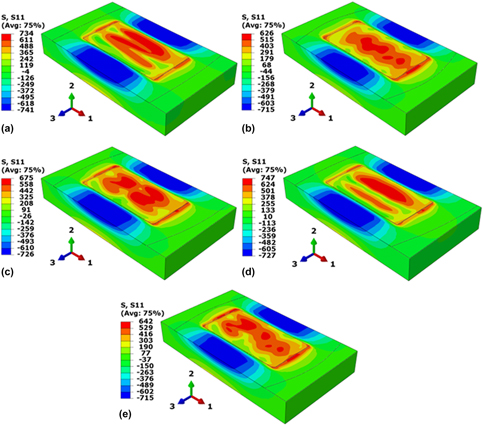Crossref Citations
This article has been cited by the following publications. This list is generated based on data provided by
Crossref.
Levkulich, N.C.
Semiatin, S.L.
Gockel, J.E.
Middendorf, J.R.
DeWald, A.T.
and
Klingbeil, N.W.
2019.
The effect of process parameters on residual stress evolution and distortion in the laser powder bed fusion of Ti-6Al-4V.
Additive Manufacturing,
Vol. 28,
Issue. ,
p.
475.
Zhang, Liang
Wu, Kaiqi
Yang, Qiyun
Ni, Xiaoqing
Wang, Tao
Wu, Wenheng
and
Lu, Lin
2020.
Effect of Heat Input Parameters on Molten Pool Size during Selective Laser Melting of Ti-6Al-4V Powder Through Numerical Simulation.
IOP Conference Series: Materials Science and Engineering,
Vol. 730,
Issue. 1,
p.
012003.
Bai, Qian
Wu, Bingzhe
Qiu, Xiaoling
Zhang, Bi
and
Chen, Juanjuan
2020.
Experimental study on additive/subtractive hybrid manufacturing of 6511 steel: process optimization and machining characteristics.
The International Journal of Advanced Manufacturing Technology,
Vol. 108,
Issue. 5-6,
p.
1389.
Sui, Qingxuan
Meng, Lingtao
Wang, Shenghai
Li, Peizhen
Yin, Xiaotian
and
Wang, Li
2020.
Effect of Nb addition on mechanical properties and corrosion behavior of Ti6Al4V alloy produced by selective laser melting.
Journal of Materials Research,
Vol. 35,
Issue. 6,
p.
571.
Rupal, Baltej Singh
Anwer, Nabil
Secanell, Marc
and
Qureshi, Ahmed Jawad
2020.
Geometric tolerance and manufacturing assemblability estimation of metal additive manufacturing (AM) processes.
Materials & Design,
Vol. 194,
Issue. ,
p.
108842.
Chen, Changpeng
Xiao, Zhongxu
Zhu, Haihong
and
Zeng, Xiaoyan
2020.
Distribution and evolution of thermal stress during multi-laser powder bed fusion of Ti-6Al-4 V alloy.
Journal of Materials Processing Technology,
Vol. 284,
Issue. ,
p.
116726.
Chen, Changpeng
Chang, Shijie
Zhu, Junjie
Xiao, Zhongxu
Zhu, Haihong
and
Zeng, Xiaoyan
2020.
Residual stress of typical parts in laser powder bed fusion.
Journal of Manufacturing Processes,
Vol. 59,
Issue. ,
p.
621.
GaoLe, Zhao
Yun, Jiang
XiaoAn, Hu
Jia, Huang
JinWu, Wu
and
Yun, Wang
2020.
High-temperature mechanical properties of nickel-based superalloys manufactured by additive manufacturing.
Materials Science and Technology,
Vol. 36,
Issue. 14,
p.
1523.
Salmi, Alessandro
and
Atzeni, Eleonora
2020.
Residual stress analysis of thin AlSi10Mg parts produced by Laser Powder Bed Fusion.
Virtual and Physical Prototyping,
Vol. 15,
Issue. 1,
p.
49.
Chen, Changpeng
Xiao, Zhongxu
Zhang, Wenqi
Wang, Yilong
and
Zhu, Haihong
2021.
Effect of laser jump speed on temperature distribution and thermal stress in laser powder bed fusion.
Optics & Laser Technology,
Vol. 142,
Issue. ,
p.
107275.
Dezfoli, Amir Reza Ansari
Lo, Yu-Lung
and
Raza, M. Mohsin
2021.
3D Multi-Track and Multi-Layer Epitaxy Grain Growth Simulations of Selective Laser Melting.
Materials,
Vol. 14,
Issue. 23,
p.
7346.
Hashemi, Seyed Mahdi
Parvizi, Soroush
Baghbanijavid, Haniyeh
Tan, Alvin T. L.
Nematollahi, Mohammadreza
Ramazani, Ali
Fang, Nicholas X.
and
Elahinia, Mohammad
2022.
Computational modelling of process–structure–property–performance relationships in metal additive manufacturing: a review.
International Materials Reviews,
Vol. 67,
Issue. 1,
p.
1.
Abdelmoula, Mohamed
Küçüktürk, Gökhan
Juste, Enrique
and
Petit, Fabrice
2022.
Powder Bed Selective Laser Processing of Alumina: Scanning Strategies Investigation.
Applied Sciences,
Vol. 12,
Issue. 2,
p.
764.
Stegman, Benjamin
Yang, Bo
Shang, Zhongxia
Ding, Jie
Sun, Tianyi
Lopez, Jack
Jarosinski, William
Wang, Haiyan
and
Zhang, Xinghang
2022.
Reactive introduction of oxide nanoparticles in additively manufactured 718 Ni alloys with improved high temperature performance.
Journal of Alloys and Compounds,
Vol. 920,
Issue. ,
p.
165846.
Kwabena Adomako, Nana
Haghdadi, Nima
and
Primig, Sophie
2022.
Electron and laser-based additive manufacturing of Ni-based superalloys: A review of heterogeneities in microstructure and mechanical properties.
Materials & Design,
Vol. 223,
Issue. ,
p.
111245.
Gao, Yingming
Bai, Qian
Zhang, Yingwei
and
Ye, Xuexia
2022.
Surface quality of overhang features in hybrid manufacturing.
p.
146.
Borhani, Mohammad Reza
Rajabi, Mohammad
Shoja Razavi, Reza
and
Jamaati, Roohollah
2023.
Investigating the relationship between mechanical properties and residual stress in the laser cladding process of Inconel 625 superalloy.
Heliyon,
Vol. 9,
Issue. 9,
p.
e19791.
Ningthemba Singh, Sapam
Deoghare, Ashish B.
and
Nirsanametla, Yadaiah
2023.
Study of thermal behavior during the directed energy deposition (DED) of Ti6Al4V alloy using finite element modeling (FEM).
Materials Today: Proceedings,
Vol. 76,
Issue. ,
p.
617.
Rashid, Asim
and
Gopaluni, Aditya
2023.
A Review of Residual Stress and Deformation Modeling for Metal Additive Manufacturing Processes.
Chinese Journal of Mechanical Engineering: Additive Manufacturing Frontiers,
Vol. 2,
Issue. 4,
p.
100102.
Ahmed, Nissar
Barsoum, Imad
and
Abu Al-Rub, Rashid K.
2023.
Numerical investigation of residual stresses in thin-walled additively manufactured structures from selective laser melting.
Heliyon,
Vol. 9,
Issue. 9,
p.
e19385.





